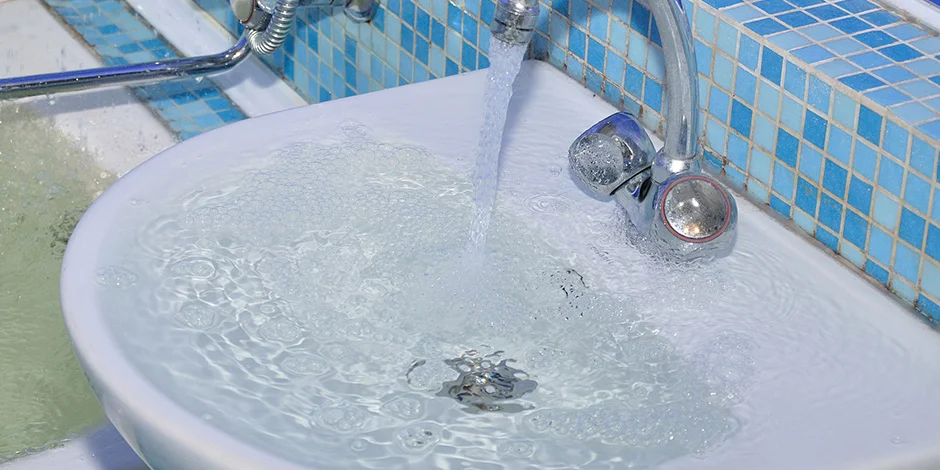How to unclog a kitchen sink is often much easier than most people think. Having a clogged/blocked sink can be so annoying because it is inconvenient, unsightly, and unsanitary. You might even need to get a plumber, depending on how serious the clog is. There is never a good time to have a clogged sink.
A clogged sink can just come out of nowhere, and also at the most unfortunate of times, like when you’re about to have guests come over for a dinner party. A clogged drain is always caused by foreign objects, food, grease, coffee grounds, or eggshells. In other words, it’s pretty much everything you want to avoid going down your drain.
There are different methods to unclog your sink like, electric snake, hydro jetting, and open pipe cleaning. With these tips and tricks, you can unclog your kitchen sink.
All you need may just be for you to invest a little time and effort in fixing the clogged problem yourself, and usually, the time spent is always worth it. Most clogs can be resolved by simple tools and straightforward techniques.
After unclogging the sink, it is important to minimize the chances of the problem reoccurring which I am going to talk about the prevention at the end of this article, but right now, let us talk about how to unclog a kitchen sink.
How To Unclog A Kitchen Sink
1. Boiling Water:
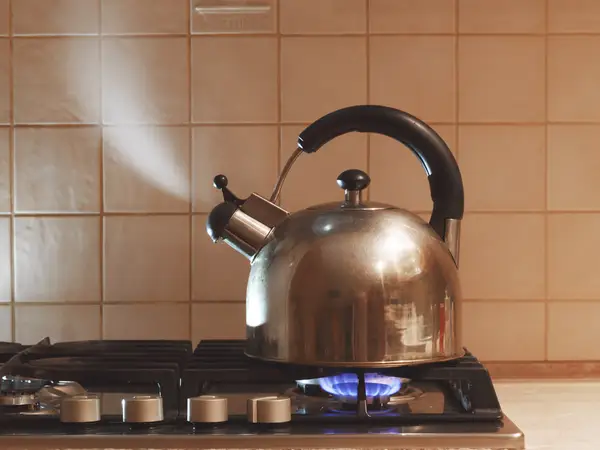
For some clogs, pouring of boiling water into the sink will do the trick. The president of bluefrog Plumbing & Drain Mike Mushinski, said that “the use of boiling water is the easiest way to unclog a sink”. However, he also warns that this method comes with some of its own risks. “If your pipes are not rated for a minimum of 212 degrees Fahrenheit, the boiling water could melt or deform your drain piping, which could end up causing leakage,” he warns.
This is only a big problem if you have PVC or plastic pipes, but if you know your pipes are thick and strong enough, this method is very effective to melt out whatever is causing the clogging. When hair, grease, soap residue and other debris get stuck in your drain, boiling water may be all your pipes needs to loosen the blockage. To do this method:
- Put a kettle or a pot of water on a stove and allow it to very well.
- While waiting for the water to heat up and boil, remove as much standing/ stagnant water from the sink as possible, using a mug or small pot to bail out the water.
- Slowly pour the water down the drain.
- Wait a few seconds between pours. Allow the boiling water to melt soap scum and dissolve grime or loosen solids, etc.
- Repeat as necessary until the water finishes.
If the boiling water fails to dislodge the clog after the hot water method, then it means unfortunately, you have yourself a sink clog that is too stubborn for the simple boiling water approach, then it’s time to try another method.
2. Use A Plunger:
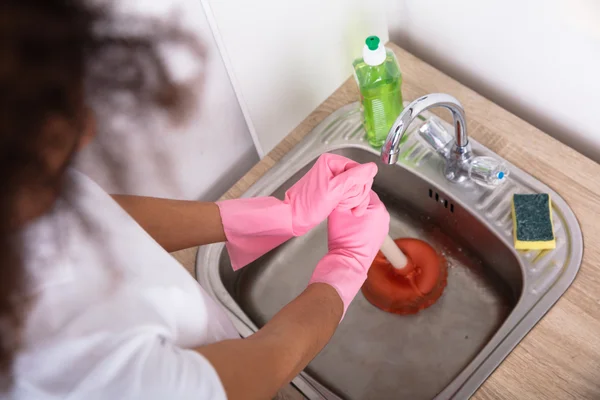
If your drain is clogged, or it is just not running as smoothly as it should, the first step that should come into your mind is to use a drain plunger. Plungers are not just great to use when you want to unclog a toilet, they are also a very effective handy tool to unclog a sink. Most often, making use of a plunger can loosen up any food or debris that has been lodged in the sink, making water flow easily down the drain. To a plunger, follow these steps:
- If it is a double sink in a kitchen, also plug the drain on the opposite side or use towel to plunge the unclogged sink so that when plunging, you are not forcing air out of the open drain but rather towards the clog.
- Place the plunger cup over the clogged drain and make sure you seal the drain hole well.
- If there is no standing water in the sink, add some now. Add enough water to cover the plunger cup.
- Plunge the drain, giving it a few bumps. Make 6 even, up-and-down thrusts, keeping the seal intact.
- Remove the plunger, if the water drains away, you have successfully cleared the clog. If it doesn’t, repeat the process again.
3. Use A Coat Hanger:

A wire coat hanger is also an effective tool if your kitchen sink is clogged. It won’t reach into your kitchen sink plumbing as far as a plumber’s snake would, but it may be long enough to reach some clogs. Insert the straightened hanger wire into the kitchen drain or “stub pipe” to push through or pull out the clog if you can reach it. Be careful not to scratch your sink with the wire.
You may also want to invest in a plastic drain clog remover tool to help get rid of the gunk. This tool is designed to help remove hair from your slow-draining sink or shower, but it can also be used to catch stubborn food particles in your clogged kitchen sink. Just be careful to go slowly and gently because the thin plastic can break off and cause more problems.
4. Use A Plumbers’ Snake:
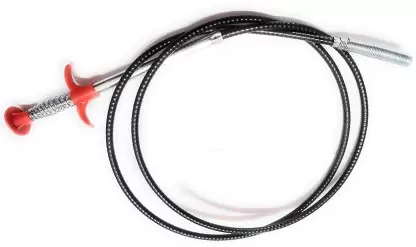
If the coat hanger didn’t work, head to the hardware store and buy a plumber’s snake. A plumbers snake is another great tool to unclog sinks. This tool consists of a coiled spiral snake, typically around 1/4-inch thick, with a handle at one end. The coil is used to reach down into the drain, and then the handle is cranked, dislodging and pulling up the clog. Some snakes are manually cranked, while others are electrically powered for extra strength.
- Insert the hooked end of the wire down the drain and gently wiggle it around a bit, trying to find the clog. Do not push down too roughly, as this might push the blockage further down the pipe.
- If you feel anything at the end of the wire, pull it up and out of the drain. You might not be able to remove the whole clog all at once, so try again to see if anything else comes up. Turn on the hot water from your faucet to make sure you got everything.
If you try this trick and fail to find the blockage, it could be that the clog is further down the drain than the wire is able to reach. In this case, try one of the other methods listed in this article.
5. Baking Soda And Vinegar:
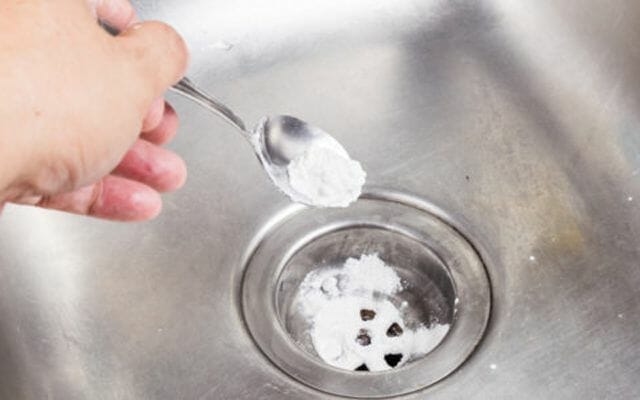
Using baking soda and white vinegar can break free light stoppages, making it very great and effective, but it’s not meant for large blockages. If you choose to try this method, there should be no standing water in the sink, so the baking soda and vinegar can get to your clog faster and more effectively. The procedure to try this method is;
- Pour a pot of boiling water down the drain.
- Pour 1 cup of baking soda down the drain.
- Pour 1 cup of white vinegar down the drain.
- Cover with a drain plug and wait for about 15 minutes.
- Pour boiling water down the drain again.
- Repeat as necessary.
6. Clean The P-Trap:
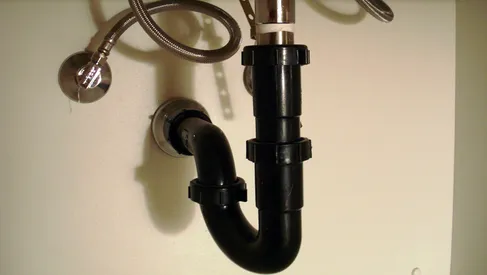
The P-trap is at the curved part of your kitchen sink pipes, usually inside a cabinet. The P-trap is shaped like an elbow pipe under the sink. If this gets clogged with food and/or grease, then you may want to take it apart and clean out the gunk that is causing the blockage. Cleaning your kitchen drain’s P-trap is necessary to clear the clog.
- First, place a bucket underneath the drain to catch any water or debris that may fall out.
- Then, unfasten the P-trap from the drainpipe and clear out anything that is stuck.
- Finally, replace the P-trap (make sure all connections are closed tight) and run warm water through the pipes for a few minutes.
7. Call A Plumber:
If you have tried all of the above and you don’t see any positive result, it’s time to call a professional plumber.
Tips For Preventing Future Clogs
- Don’t use your drain as a trash can. Large bones, coffee grounds, and fibrous vegetables shouldn’t go in your sink.
- Don’t pour grease or oil down your drain. It can harden as it cools, causing clogs.
- When leaning over your bathroom sink, be careful not to let hair, Q-tips, dental floss, or other items fall into the sink.
- Don’t dispose of paint in the sink.
- Invest in a sink strainer to catch wayward objects like hair, food, etc.
- Run hot water down the drain on a regular basis to flush out debris.
- Use the vinegar and baking soda method once a month as a preventative measure. It will remove debris before it becomes a large blockage.
Read Also: 19 Essential Kitchen Utensils For Every Woman
Conclusion
How to unclog a kitchen sink is not as difficult as people think. If you have a clogged sink, start by pouring a pot of boiling water down the drain. If this doesn’t work, try a combination of baking soda and vinegar. The next method is to use a plunger, if you do not have a plunger, you can use the palm of your hand as a plunger. If the clog still won’t move, try a plumbing snake. If at any point you feel unconfident about moving on to the next method, you can just call a plumber to take care of the issue.


